新编简明英语语言学教程中文版
新编简明英语语言学教程中文版-2
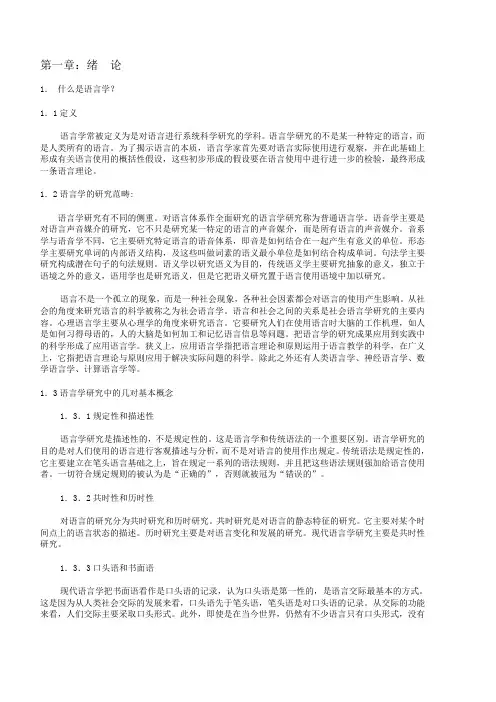
第一章:绪论1.什么是语言学?1.1定义语言学常被定义为是对语言进行系统科学研究的学科。
语言学研究的不是某一种特定的语言,而是人类所有的语言。
为了揭示语言的本质,语言学家首先要对语言实际使用进行观察,并在此基础上形成有关语言使用的概括性假设,这些初步形成的假设要在语言使用中进行进一步的检验,最终形成一条语言理论。
1.2语言学的研究范畴:语言学研究有不同的侧重。
对语言体系作全面研究的语言学研究称为普通语言学。
语音学主要是对语言声音媒介的研究,它不只是研究某一特定的语言的声音媒介,而是所有语言的声音媒介。
音系学与语音学不同,它主要研究特定语言的语音体系,即音是如何结合在一起产生有意义的单位。
形态学主要研究单词的内部语义结构,及这些叫做词素的语义最小单位是如何结合构成单词。
句法学主要研究构成潜在句子的句法规则。
语义学以研究语义为目的,传统语义学主要研究抽象的意义,独立于语境之外的意义,语用学也是研究语义,但是它把语义研究置于语言使用语境中加以研究。
语言不是一个孤立的现象,而是一种社会现象,各种社会因素都会对语言的使用产生影响。
从社会的角度来研究语言的科学被称之为社会语言学。
语言和社会之间的关系是社会语言学研究的主要内容。
心理语言学主要从心理学的角度来研究语言。
它要研究人们在使用语言时大脑的工作机理,如人是如何习得母语的,人的大脑是如何加工和记忆语言信息等问题。
把语言学的研究成果应用到实践中的科学形成了应用语言学。
狭义上,应用语言学指把语言理论和原则运用于语言教学的科学,在广义上,它指把语言理论与原则应用于解决实际问题的科学。
除此之外还有人类语言学、神经语言学、数学语言学、计算语言学等。
1.3语言学研究中的几对基本概念1.3.1规定性和描述性语言学研究是描述性的,不是规定性的。
这是语言学和传统语法的一个重要区别。
语言学研究的目的是对人们使用的语言进行客观描述与分析,而不是对语言的使用作出规定。
传统语法是规定性的,它主要建立在笔头语言基础之上,旨在规定一系列的语法规则,并且把这些语法规则强加给语言使用者。
新编简明英语语言学教程中文版 2
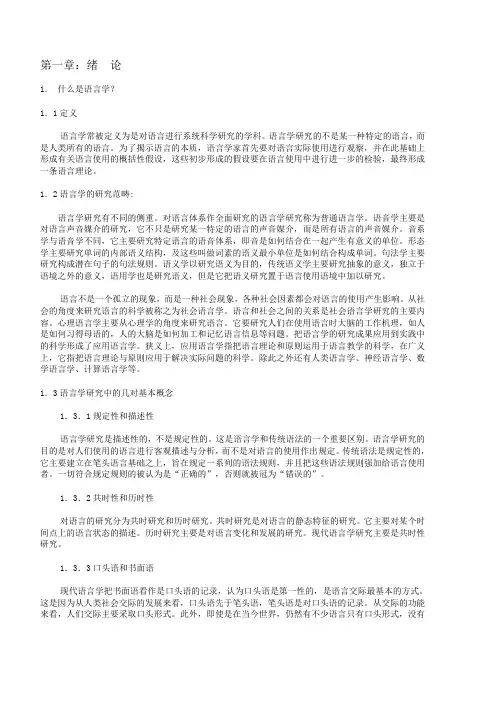
第一章:绪论1.什么是语言学?1.1定义语言学常被定义为是对语言进行系统科学研究的学科。
语言学研究的不是某一种特定的语言,而是人类所有的语言。
为了揭示语言的本质,语言学家首先要对语言实际使用进行观察,并在此基础上形成有关语言使用的概括性假设,这些初步形成的假设要在语言使用中进行进一步的检验,最终形成一条语言理论。
1.2语言学的研究范畴:语言学研究有不同的侧重。
对语言体系作全面研究的语言学研究称为普通语言学。
语音学主要是对语言声音媒介的研究,它不只是研究某一特定的语言的声音媒介,而是所有语言的声音媒介。
音系学与语音学不同,它主要研究特定语言的语音体系,即音是如何结合在一起产生有意义的单位。
形态学主要研究单词的内部语义结构,及这些叫做词素的语义最小单位是如何结合构成单词。
句法学主要研究构成潜在句子的句法规则。
语义学以研究语义为目的,传统语义学主要研究抽象的意义,独立于语境之外的意义,语用学也是研究语义,但是它把语义研究置于语言使用语境中加以研究。
语言不是一个孤立的现象,而是一种社会现象,各种社会因素都会对语言的使用产生影响。
从社会的角度来研究语言的科学被称之为社会语言学。
语言和社会之间的关系是社会语言学研究的主要内容。
心理语言学主要从心理学的角度来研究语言。
它要研究人们在使用语言时大脑的工作机理,如人是如何习得母语的,人的大脑是如何加工和记忆语言信息等问题。
把语言学的研究成果应用到实践中的科学形成了应用语言学。
狭义上,应用语言学指把语言理论和原则运用于语言教学的科学,在广义上,它指把语言理论与原则应用于解决实际问题的科学。
除此之外还有人类语言学、神经语言学、数学语言学、计算语言学等。
1.3语言学研究中的几对基本概念1.3.1规定性和描述性语言学研究是描述性的,不是规定性的。
这是语言学和传统语法的一个重要区别。
语言学研究的目的是对人们使用的语言进行客观描述与分析,而不是对语言的使用作出规定。
传统语法是规定性的,它主要建立在笔头语言基础之上,旨在规定一系列的语法规则,并且把这些语法规则强加给语言使用者。
新编简明英语语言学教程中文版-2
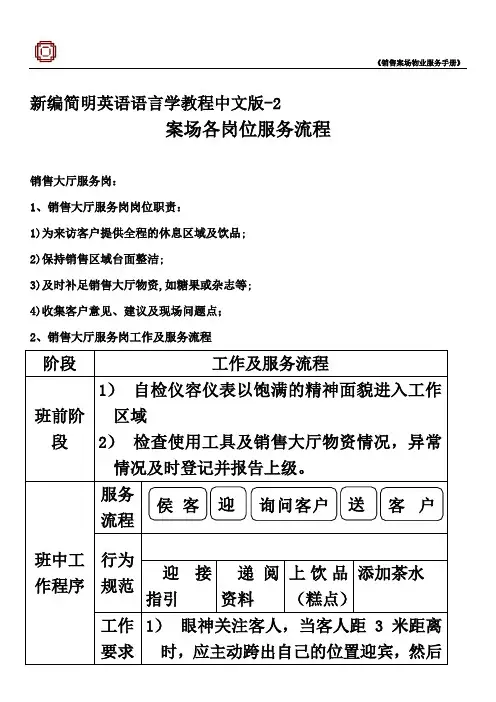
新编简明英语语言学教程中文版-2案场各岗位服务流程销售大厅服务岗:1、销售大厅服务岗岗位职责:1)为来访客户提供全程的休息区域及饮品;2)保持销售区域台面整洁;3)及时补足销售大厅物资,如糖果或杂志等;4)收集客户意见、建议及现场问题点;2、销售大厅服务岗工作及服务流程阶段工作及服务流程班前阶段1)自检仪容仪表以饱满的精神面貌进入工作区域2)检查使用工具及销售大厅物资情况,异常情况及时登记并报告上级。
班中工作程序服务流程行为规范迎接指引递阅资料上饮品(糕点)添加茶水工作要求1)眼神关注客人,当客人距3米距离时,应主动跨出自己的位置迎宾,然后侯客迎询问客户送客户注意事项15度鞠躬微笑问候:“您好!欢迎光临!”2)在客人前方1-2米距离领位,指引请客人向休息区,在客人入座后问客人对座位是否满意:“您好!请问坐这儿可以吗?”得到同意后为客人拉椅入座“好的,请入座!”3)若客人无置业顾问陪同,可询问:请问您有专属的置业顾问吗?,为客人取阅项目资料,并礼貌的告知请客人稍等,置业顾问会很快过来介绍,同时请置业顾问关注该客人;4)问候的起始语应为“先生-小姐-女士早上好,这里是XX销售中心,这边请”5)问候时间段为8:30-11:30 早上好11:30-14:30 中午好 14:30-18:00下午好6)关注客人物品,如物品较多,则主动询问是否需要帮助(如拾到物品须两名人员在场方能打开,提示客人注意贵重物品);7)在满座位的情况下,须先向客人致歉,在请其到沙盘区进行观摩稍作等待;阶段工作及服务流程班中工作程序工作要求注意事项饮料(糕点服务)1)在所有饮料(糕点)服务中必须使用托盘;2)所有饮料服务均已“对不起,打扰一下,请问您需要什么饮品”为起始;3)服务方向:从客人的右面服务;4)当客人的饮料杯中只剩三分之一时,必须询问客人是否需要再添一杯,在二次服务中特别注意瓶口绝对不可以与客人使用的杯子接触;5)在客人再次需要饮料时必须更换杯子;下班程序1)检查使用的工具及销售案场物资情况,异常情况及时记录并报告上级领导;2)填写物资领用申请表并整理客户意见;3)参加班后总结会;4)积极配合销售人员的接待工作,如果下班时间已经到,必须待客人离开后下班;1.3.3.3吧台服务岗1.3.3.3.1吧台服务岗岗位职责1)为来访的客人提供全程的休息及饮品服务;2)保持吧台区域的整洁;3)饮品使用的器皿必须消毒;4)及时补充吧台物资;5)收集客户意见、建议及问题点;1.3.3.3.2吧台服务岗工作及流程阶段工作及服务流程班前阶段1)自检仪容仪表以饱满的精神面貌进入工作区域2)检查使用工具及销售大厅物资情况,异常情况及时登记并报告上级。
新编简明英语语言学教程课文翻译
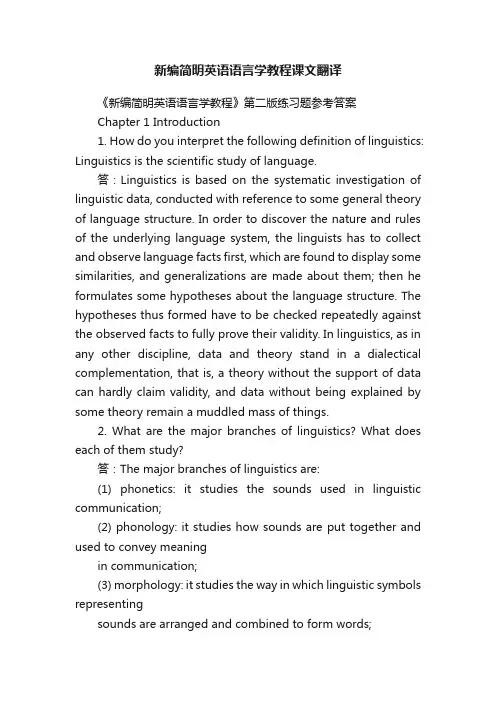
新编简明英语语言学教程课文翻译《新编简明英语语言学教程》第二版练习题参考答案Chapter 1 Introduction1. How do you interpret the following definition of linguistics: Linguistics is the scientific study of language.答:Linguistics is based on the systematic investigation of linguistic data, conducted with reference to some general theory of language structure. In order to discover the nature and rules of the underlying language system, the linguists has to collect and observe language facts first, which are found to display some similarities, and generalizations are made about them; then he formulates some hypotheses about the language structure. The hypotheses thus formed have to be checked repeatedly against the observed facts to fully prove their validity. In linguistics, as in any other discipline, data and theory stand in a dialectical complementation, that is, a theory without the support of data can hardly claim validity, and data without being explained by some theory remain a muddled mass of things.2. What are the major branches of linguistics? What does each of them study?答:The major branches of linguistics are:(1) phonetics: it studies the sounds used in linguistic communication;(2) phonology: it studies how sounds are put together and used to convey meaningin communication;(3) morphology: it studies the way in which linguistic symbols representingsounds are arranged and combined to form words;(4) syntax: it studies the rules which govern how words are combined to formgrammatically permissible sentences in languages;(5) semantics: it studies meaning conveyed by language;(6) pragmatics: it studies the meaning in the context of language use.3. In what basic ways does modern linguistics differ from traditional grammar?答:The general approach thus traditionally formed to the study of language over the years is roughly referred to as “t raditional gramma r.” Modern linguistics differs from traditional grammar in several basic ways.Firstly, linguistics is descriptive while traditional grammar is prescriptive.Second, modem linguistics regards the spoken language as primary, not the written. Traditional grammarians, on the other hand, tended to emphasize, maybe over-emphasize, the importance of the written word, partly because of its permanence.Then, modem linguistics differs from traditional grammar also in that it does not force languages into a Latin-based framework.4. Is modern linguistics mainly synchronic or diachronic? Why?答:In modem linguistics, a synchronic approach seems to enjoy priority over a diachronic one. Because people believed that unless the various states of a language in different historical periods are successfully studied, it would be difficult to describe the changes that have taken place in its historical development.5. For what reasons does modern linguistics give priority to speech rather than to writing?答:Speech and writing are the two major media of linguisticcommunication. Modem linguistics regards the spoken language as the natural or the primary medium of human language for some obvious reasons. From the point of view of linguistic evolution, speech is prior to writing. The writing system of any language is always “invented” by its users to reco rd speech when the need arises. Even in today's world there are still many languages that can only be spoken but not written. Then in everyday communication, speech plays a greater role than writing in terms of the amount of information conveyed. And also, speech is always the way in which every native speaker acquires his mother tongue, and writing is learned and taught later when he goes to school. For modern linguists, spoken language reveals many true features of human speech while written language is o nly the “revised” record of s peech. Thus their data for investigation and analysis are mostly drawn from everyday speech, which they regard as authentic.6. How is Saussure's distinction between langue and parole similar to Chomsky's distinction between competence and performance?答:Saussure's distinction and Chomsky's are very similar, they differ at least in that Saussure took a sociological view of language and his notion of langue is a matter of social conventions, and Chomsky looks at language from a psychological point of view and to him competence is a property of the mind of each individual.7. What characteristics of language do you think should be included in a good, comprehensive definition of language?答:First of all, language is a system, i.e., elements of language are combined according to rules.Second, language is arbitrary in the sense that there is nointrinsic connection between a linguistic symbol and what the symbol stands for.Third, language is vocal because the primary medium for all languages is sound.Fourth, language is human-specific, i. e., it is very different from the communication systems other forms of life possess.8. What are the main features of human language that have been specified by C. Hockett to show that it is essentially different from animal communication system? 答:The main features of human language are termed design features. They include:1) ArbitrarinessLanguage is arbitrary. This means that there is no logical connection between meanings and sounds. A good example is the fact that different sounds are used to refer to the same object in different languages.2) ProductivityLanguage is productive or creative in that it makes possible the construction and interpretation of new signals by its users. This is why they can produce and understand an infinitely large number of sentences, including sentences they have never heard before.3) DualityLanguage consists of two sets of structures, or two levels. At the lower or thebasic level there is a structure of sounds, which are meaningless by themselves. But the sounds of language can be grouped and regrouped into a large number of units of meaning, which are found at the higher level of the system.4) DisplacementLanguage can be used to refer to things which are present ornot present, real or imagined matters in the past, present, or future, or in far-away places. In other words, language can be used to refer to contexts removed from the immediate situations of the spe aker. This is what “displacement” means.5) Cultural transmissionWhile human capacity for language has a genetic basis, i.e., we were all born with the ability to acquire language, the details of any language system are not genetically transmitted, but instead have to be taught and learned.9. What are the major functions of language? Think of your own examples for illustration.答:Three main functions are often recognized of language: the descriptive function, the expressive function, and the social function.The descriptive function is the function to convey factual information, which can be asserted or denied, and in some cases even verified. For example: “China is a large country with a long history.”The expressive function supplies information about the user?s feelings, preferences, prejudices, and values. For example: “I will never go window-shopping with her.”The social function serves to establish and maintain social relations between people. . For example: “We are your firm supporters.”Chapter 2 Speech Sounds1. What are the two major media of linguistic communication? Of the two, which oneis primary and why?答:Speech and writing are the two major media of linguistic communication.Of the two media of language, speech is more primary than writing, for reasons, please refer to the answer to the fifth problem in the last chapter.2. What is voicing and how is it caused?答:V oicing is a quality of speech sounds and a feature of all vowels and some consonants in English. It is caused by the vibration of the vocal cords.3. Explain with examples how broad transcription and narrow transcription differ? 答:The transcription with letter-symbols only is called broad transcription. This is the transcription normally used in dictionaries and teaching textbooks for general purposes. The latter, i.e. the transcription with letter-symbols together with the diacritics is called narrow transcription. This is the transcription needed and used by the phoneticians in their study of speech sounds. With the help of the diacritics they can faithfully represent as much of the fine details as it is necessary for their purpose.In broad transcription, the symbol [l] is used for the sounds [l] in the four words leaf [li:f], feel [fi:l], build [bild], and health [helθ]. As a matter of fact, the sound [l] inall these four sound combinations differs slightly. The [l] in [li:f], occurring before a vowel, is called a dear [l], and no diacritic is needed to indicate it; the [1] in [fi:l] and [bild], occurring at the end of a word or before another consonant, is pronounced differently from the clear [1] as in “leaf”. It is called dark[?] and in narrow transcription the diacritic [?] is used to indicate it. Then in the sound combination [helθ], the sound [l] is followed by the English dental sound [θ], its pronunciation is somewhat affected by the dental sound that follows it. It is thus called a dental [l], and in narrow transcription the diacritic [、] is used to indicate it.It is transcribed as [helθ].Another example is the consonant [p]. We all know that [p] is pronounced differently in the two words pit and spit. In the word pit, the sound [p] is pronounced with a strong puff of air, but in spit the puff of air is withheld to some extent. In the case of pit, the [p] sound is said to be aspirated and in the case of spit, the [p] sound is unaspirated. This difference is not shown in broad transcription, but in narrow transc ription, a small raised “h” is used to show aspiration, thus pit is transcribed as [p h?t] and spit is transcribed as [sp?t].4. How are the English consonants classified?答:English consonants can be classified in two ways: one is in terms of manner of articulation and the other is in terms of place of articulation. In terms of manner of articulation the English consonants can be classified into the following types: stops, fricatives, affricates, liquids, nasals and glides. In terms of place of articulation, it can be classified into following types: bilabial, labiodental, dental, alveolar, palatal, velar and glottal.5. What criteria are used to classify the English vowels?答:V owels may be distinguished as front, central, and back according to which part of the tongue is held highest. To further distinguish members of each group, we need to apply another criterion, i.e. the openness of the mouth. Accordingly, we classify the vowels into four groups: close vowels, semi-close vowels, semi-open vowels, and open vowels. A third criterion that is often used in the classification of vowels is the shape of the lips. In English, all the front vowels and the central vowels are unfounded vowels, i. e., without rounding the lips, and all the back vowels, with the exception of [a:], are rounded. It should be noted that some front vowels can be pronounced with rounded lips.6. A. Give the phonetic symbol for each of the following sound descriptions:1) voiced palatal affricate2) voiceless labiodental fricative3) voiced alveolar stop4) front, close, short5) back, semi-open, long6) voiceless bilabial stopB. Give the phonetic features of each of the following sounds:1) [ t ] 2) [ l ] 3) [?] 4) [w] 5) [?] 6) [?]答:A. (1) [?] (2) [ f ] (3) [d ] (4) [ ?] (5) [?:] (6) [p]B. (1) voiceless alveolar stop (2) voiced alveolar liquid(3) voiceless palatal affricate (4) voiced bilabial glide(5) back, close, short (6) front, open7. How do phonetics and phonology differ in their focus of study? Who do you think will be more interested in the difference between, say, [l] and [?], [p h] and [p], a phonetician or a phonologist? Why?答:(1) Both phonology and phonetics are concerned with the same aspect of language ––the speech sounds. But while both are related to the study of sounds,, they differ in their approach and focus. Phonetics is of a general nature; it is interested in all the speech sounds used in all human languages: how they are produced, how they differ from each other, what phonetic features they possess, how they can be classified, etc. Phonology, on the other hand, aims to discover how speech sounds in a language form patterns and how these sounds are used to convey meaning in linguistic communication.(2) A phonologist will be more interested in it. Because one of the tasks of the phonologists is to find out rule that governsthe distribution of [l] and [?], [p h] and [p].8. What is a phone? How is it different from a phoneme? How are allophones relatedto a phoneme?答:A phone is a phonetic unit or segment. The speech sounds we hear and produce during linguistic communication are all phones. A phoneme is not any particular sound, but rather it is represented or realized by a certain phone in a certain phonetic context. The different phones which can represent a phoneme in different phonetic environments are called the allophones of that phoneme. For example, the phoneme /l/ in English can be realized as dark [?], clear [l], etc. which are allophones of the phoneme /l/.9. Explain with examples the sequential rule, the assimilation rule, and the deletion rule.答:Rules that govern the combination of sounds in a particular language are called sequential rules.There are many such sequential rules in English. For example, if a word begins with a [l] or a [r], then the next sound must be a vowel. That is why [lbik] [lkbi] are impossible combinations in English. They have violated the restrictions on the sequencing of phonemes.The assimilation rule assimilates one sound to another by “copying” a feature of a sequential phoneme, thus making the two phones similar. Assimilation of neighbouring sounds is, for the most part, caused by articulatory or physiological processes. When we speak, we tend to increase the ease of articulation. This “sloppy” tendency may become regularized as rules of language.We all know that nasalization is not a phonological featurein English, i.e., it does not distinguish meaning. But this does not mean that vowels in English are never nasalized in actual pronunciation; in fact they are nasalized in certain phonetic contexts. For example, the [i:] sound is nasalized in words like bean, green, team, and scream. This is because in all these sound combinations the [i:] sound is followed by a nasal [n] or [m].The assimilation rule also accounts for the varying pronunciation of the alveolar nasal [n] in some sound combinations. The rule is that within a word, the nasal [n] assumes the same place of articulation as the consonant that follows it. We know that in English the prefix in- can be added to ma adjective to make the meaning of the word negative, e.g. discreet – indiscreet, correct – incorrect. But the [n] sound in the prefix in- is not always pronounced as an alveolar nasal. It is so in the word indiscreet because the consonant that follows it, i.e.[d], is an alveolar stop, but the [n] sound in the word incorrect is actually pronounced as a velar nasal, i.e. [?]; this is bec ause the consonant that follows it is [k], which is a velar stop. So we can see that while pronouncing the sound [n], we are “copying” a feature of the consonant that follows it.Deletion rule tells us when a sound is to be deleted although it is orthographically represented. We have noticed that in the pronunciation of such words as sign, design, and paradigm, there is no [g] sound although it is represented in spelling by the letter g. But in their corresponding forms signature, designation, and paradigmatic, the [g] represented by the letter g is pronounced. The rule can be stated as: Delete a [g] when it occurs before a final nasal consonant. Given the rule, the phonemic representation of the stems in sign –signature, resign –resignation, phlegm – phlegmatic, paradigm – paradigmatic willinclude the phoneme /g/, which will be deleted according to the regular rule if no suffix is added.10. What are suprasegmental features? How do the major suprasegmental features ofEnglish function in conveying meaning?答:The phonemic features that occur above the level of the segments are called suprasegmental features. The main suprasegmental features include stress, intonation, and tone. The location of stress in English distinguishes meaning. There are two kinds of stress: word stress and sentence stress. For example, a shift of stress may change the part of speech of a word from a noun, to a verb although its spelling remains unchanged. Tones are pitch variations which can distinguish meaning just like phonemes.Intonation plays an important role in the conveyance of meaning in almost every language, especially in a language like English. When spoken in different tones, the same sequence of words may have different meanings.Chapter 3 Morphology1. Divide the following words into their separate morphemes by placing a “+” betwee n each morpheme and the next:a. microfile e. telecommunicationb. bedraggled f. forefatherc. announcement g. psychophysicsd. predigestion h. mechanist答:a. micro + file b. be + draggle + edc. announce + mentd. pre + digest + ione. tele + communicate + ionf. fore + fatherg. psycho + physics h. mechan + ist2. Think of three morpheme suffixes, give their meaning, and specify the types of stem they may be suffixed to. Give at least two examples of each.Model: -orsuffix: -ormeaning: the person or thing performing the actionstem type: added to verbsexamples: actor, “one who acts in stage plays, motion pictures, etc.”translator, “one who translates”答:(1) suffix: -ablemeaning: something can be done or is possiblestem type: added to verbsexamples: acceptable, “can be accepted”respectable, “can be respected”(2) suffix: -lymeaning: functionalstem type: added to adjectivesexamples: freely. “adverbial form of …free? ”quickly, “adverbial form of 'quick' ”.(3) suffix: -eemeaning: the person receiving the actionstem type: added to verbsexamples: employee, “one who works in a company”interviewee, “one who is interviewed”3. Think of three morpheme prefixes, give their meaning, and specify the types of stem they may be prefixed to. Give at least two examples of each.Model: a-prefix: a-meaning: “without; not”stem type: added to adjectivesexamples: asymmetric, “lacking symmetry”asexual, “without sex or sex organs”答:(1) prefix: dis-meaning: showing an oppositestem type: added to verbs or nounsexamples : disapprove, “do not approve”dishonesty, “lack of honesty”.(2) prefix: anti-meaning: against, opposed tostem type: added to nouns or adjectivesexamples : antinuclear, “opposing the use of atomic weapons and power”antisocial, “opposed or h armful to the laws and customs of anorganized community. ”(3) prefix: counter-meaning: the opposite ofstem type: added to nouns or adjectives.examples: counterproductive, “producing results opposite to those intended”counteract, “act against and redu ce the force or effect of (sth.) ”4. The italicized part in each of the following sentences is an inflectional morpheme. Study each inflectional morpheme carefully and point out its grammatical meaning.Sue moves in high-society circles in London.A traffic warden asked John to move his car.The club has moved to Friday, February 22nd.The branches of the trees are moving back and forth.答:(1) the third person singular(2) the past tense(3) the present perfect(4) the present progressive5. Determine whether the words in each of the following groups are related to one another by processes of inflection or derivation.a) go, goes, going, goneb) discover, discovery, discoverer, discoverable, discoverabilityc) inventor, inventor?s, inventors, inventors?d) democracy, democrat, democratic, democratize答:(略)6. The following sentences contain both derivational and inflectional affixes.Underline all of the derivational affixes and circle the inflectional affixes.a) The farmer?s cows escaped.b) It was raining.c) Those socks are inexpensive.d) Jim needs the newer copy.e) The strongest rower continued.f) She quickly closed the book.g) The alphabetization went well.答:(略)Chapter 4 Syntax1. What is syntax?Syntax is a branch of linguistics that studies how words arecombined to form sentences and the rules that govern the formation of sentences.2. What is phrase structure rule?The grammatical mechanism that regulates the arrangement of elements (i.e. specifiers, heads, and complements) that make up a phrase is called a phrase structure rule.The phrase structural rule for NP, VP, AP, and PP can be written as follows: NP →(Det) N (PP) ...VP →(Qual) V (NP) ...AP →(Deg) A (PP) ...PP →(Deg) P (NP) ...The general phrasal structural rule ( X stands for the head N, V, A or P): The XP rule: XP →(specifier) X (complement)3. What is category? How to determine a word's category?Category refers to a group of linguistic items which fulfill the same or similar functions in a particular language such as a sentence, a noun phrase or a verb.To determine a word's category, three criteria are usually employed, namely meaning, inflection and distribution. A word's distributional facts together with information about its meaning and inflectional capabilities help identify its syntactic category.4. What is coordinate structure and what properties does it have?The structure formed by joining two or more elements of the same type with the help of a conjunction is called coordinate structures.Conjunction exhibits four important properties:1) There is no limit on the number of coordinated categories that can appear prior tothe conjunction.2) A category at any level (a head or an entire XP) can be coordinated.3) Coordinated categories must be of the same type.4) The category type of the coordinate phrase is identical to the category type of theelements being conjoined.5. What elements does a phrase contain and what role does each element play?A phrase usually contains the following elements: head, specifier and complement. Sometimes it also contains another kind of element termed modifier.The role of each elementHead:Head is the word around which a phrase is formed.Specifier:Specifier has both special semantic and syntactic roles. Semantically, it helps to make more precise the meaning of the head. Syntactically, it typically marks a phrase boundary.Complement:Complements are themselves phrases and provide information about entities and locations whose existence is implied by the meaning of the head.Modifier:Modifiers specify optionally expressible properties of the heads.6. What is deep structure and what is surface structure?There are two levels of syntactic structure. The first, formed by the XP rule in accordance with the head's subcategorization properties, is called deep structure (orD-structure). The second, corresponding to the final syntacticform of the sentence which results from appropriate transformations, is called surface structure (or S-structure).7. Indicate the category of each word in the following sentences.a) The old lady got off the bus carefully.Det A N V P Det N Advb) The car suddenly crashed onto the river bank.Det N Adv V P Det Nc) The blinding snowstorm might delay the opening of the schools.Det A N Aux V Det N P Det Nd) This cloth feels quite soft.Det N V Deg A(以下8-12题只作初步的的成分划分,未画树形图, 仅供参考)8. The following phrases include a head, a complement, anda specifier. Draw the appropriate tree structure for each.a) rich in mineralsXP(AP) →head (rich) A + complement (in minerals) PPb) often read detective storiesXP(VP) →specifier (often) Qual +head (read) V +complement (detective stories) NPc) the argument against the proposalsXP(NP) →specifier (the) Det + head (argument) N + complement (against the proposals) PPd) already above the windowXP(VP) →specifier (already) Deg + head (above) P + complement (the window)NP 9. The following sentences contain modifiers of various types. For each sentence, first identify the modifier(s), then draw the tree structures.(划底线的为动词的修饰语,斜体的为名词的修饰语)a) A crippled passenger landed the airplane with extreme caution.b) A huge moon hung in the black sky.c) The man examined his car carefully yesterday.d) A wooden hut near the lake collapsed in the storm.10. The following sentences all contain conjoined categories. Draw a tree structure foreach of the sentences. (划底线的为并列的范畴)a) Jim has washed the dirty shirts and pants.b) Helen put on her clothes and went out.c) Mary is fond of literature but tired of statistics.11. The following sentences all contain embedded clauses that function ascomplements of a verb, an adjective, a preposition or a noun. Draw a tree structurefor each sentence. (划底线的为补语从句)a) You know that I hate war.b) Gerry believes the fact that Anna flunked the English exam.c) Chris was happy that his father bought him a Rolls-Royce.d) The children argued over whether bats had wings.12. Each of the following sentences contains a relative clause. Draw the deepstructure and the surface structure trees for each of these sentences. (划底线的为关系从句)a) The essay that he wrote was excellent.b) Herbert bought a house that she lovedc) The girl whom he adores majors in linguistics.13. The derivations of the following sentences involve the inversion transformation.Give the deep structure and the surface structure of each of these sentences.a) Would you come tomorrow? (surface structure)you would come tomorrow (deep structure)b) What did Helen bring to the party? (surface structure)Helen brought what to the party (deep structure)c) Who broke the window? (surface structure)who broke the window (deep structure)Chapter 5 Semantics1. What are the major views concerning the study of meaning?答:(1) The naming theory proposed by the ancient Greek scholar Plato. According to this theory, the linguistic forms or symbols, in other words, the words used ina language are simply labels of the objects they stand for. So words are justnames or labels for things.(2) The conceptualist view has been held by some philosophers and linguistsfrom ancient times. This view holds that there is no direct link between alinguistic form and what it refers to (i. e., between language and the realworld); rather, in the interpretation of meaning they are linked through themediation of concepts in the mind.(3) The contextualist view held that meaning should be studied in terms ofsituation, use, context ––elements closely linked with language behaviour.The representative of this approach was J.R. Firth, famousBritish linguist.(4) Behaviorists attempted to define the meaning of a language form as the“situation in which the speaker utters it and the response it calls forth in thehearer.”This theory, somewhat close to contextualism, is linked withpsychological interest.2. What are the major types of synonyms in English?答:The major types of synonyms are dialectal synonyms, stylistic synonyms, emotive or evaluative synonyms, collocational synonyms, and semantically different synonyms.Examples(略)3. Explain with examples “homonymy”, “polysemy”, and “hyponymy”.答:(1) Homonymy refers to the phenomenon that words having different meanings have the same form, i.e., different words are identical in sound or spelling, or in both.When two words are identical in sound, they are homophones.When two words are identical in spelling, they are homographs.When two words are identical in both sound and spelling, they are complete homonyms(2) While different words may have the same or similar meaning, the same oneword may have more than one meaning. This is what we call polysemy, and such a word is called a polysemic word. There are many polysemic words in English, The fact is the more commonly used a word is, the more likely it has acquired more than one。
新编简明英语语言学教程中文版 2之欧阳与创编
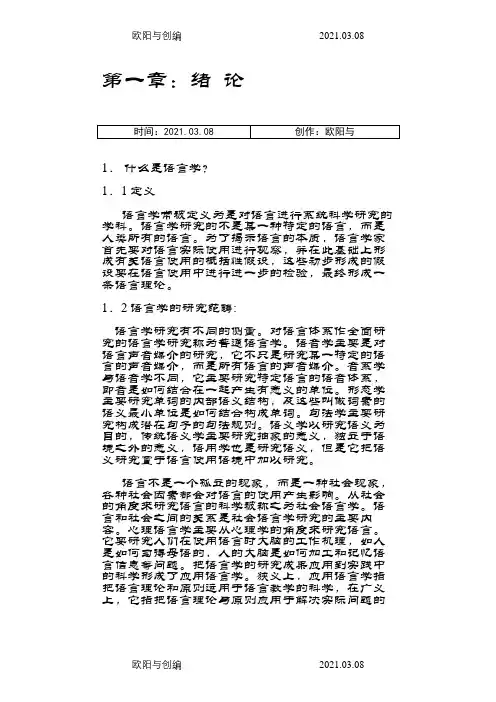
第一章:绪论1.什么是语言学?1.1定义语言学常被定义为是对语言进行系统科学研究的学科。
语言学研究的不是某一种特定的语言,而是人类所有的语言。
为了揭示语言的本质,语言学家首先要对语言实际使用进行观察,并在此基础上形成有关语言使用的概括性假设,这些初步形成的假设要在语言使用中进行进一步的检验,最终形成一条语言理论。
1.2语言学的研究范畴:语言学研究有不同的侧重。
对语言体系作全面研究的语言学研究称为普通语言学。
语音学主要是对语言声音媒介的研究,它不只是研究某一特定的语言的声音媒介,而是所有语言的声音媒介。
音系学与语音学不同,它主要研究特定语言的语音体系,即音是如何结合在一起产生有意义的单位。
形态学主要研究单词的内部语义结构,及这些叫做词素的语义最小单位是如何结合构成单词。
句法学主要研究构成潜在句子的句法规则。
语义学以研究语义为目的,传统语义学主要研究抽象的意义,独立于语境之外的意义,语用学也是研究语义,但是它把语义研究置于语言使用语境中加以研究。
语言不是一个孤立的现象,而是一种社会现象,各种社会因素都会对语言的使用产生影响。
从社会的角度来研究语言的科学被称之为社会语言学。
语言和社会之间的关系是社会语言学研究的主要内容。
心理语言学主要从心理学的角度来研究语言。
它要研究人们在使用语言时大脑的工作机理,如人是如何习得母语的,人的大脑是如何加工和记忆语言信息等问题。
把语言学的研究成果应用到实践中的科学形成了应用语言学。
狭义上,应用语言学指把语言理论和原则运用于语言教学的科学,在广义上,它指把语言理论与原则应用于解决实际问题的科学。
除此之外还有人类语言学、神经语言学、数学语言学、计算语言学等。
1.3语言学研究中的几对基本概念1.3.1规定性和描述性语言学研究是描述性的,不是规定性的。
这是语言学和传统语法的一个重要区别。
语言学研究的目的是对人们使用的语言进行客观描述与分析,而不是对语言的使用作出规定。
传统语法是规定性的,它主要建立在笔头语言基础之上,旨在规定一系列的语法规则,并且把这些语法规则强加给语言使用者。
新编简明英语语言学教程中文版
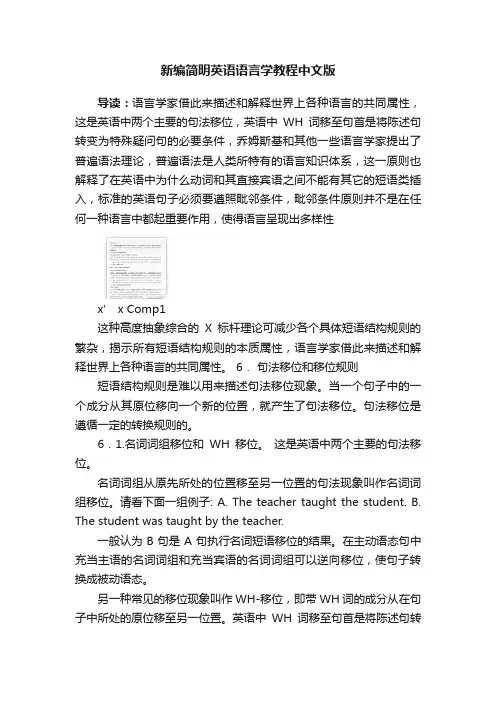
新编简明英语语言学教程中文版导读:语言学家借此来描述和解释世界上各种语言的共同属性,这是英语中两个主要的句法移位,英语中WH词移至句首是将陈述句转变为特殊疑问句的必要条件,乔姆斯基和其他一些语言学家提出了普遍语法理论,普遍语法是人类所特有的语言知识体系,这一原则也解释了在英语中为什么动词和其直接宾语之间不能有其它的短语类插入,标准的英语句子必须要遵照毗邻条件,毗邻条件原则并不是在任何一种语言中都起重要作用,使得语言呈现出多样性x’ x Comp1这种高度抽象综合的X标杆理论可减少各个具体短语结构规则的繁杂,揭示所有短语结构规则的本质属性,语言学家借此来描述和解释世界上各种语言的共同属性。
6.句法移位和移位规则短语结构规则是难以用来描述句法移位现象。
当一个句子中的一个成分从其原位移向一个新的位置,就产生了句法移位。
句法移位是遵循一定的转换规则的。
6.1.名词词组移位和WH移位。
这是英语中两个主要的句法移位。
名词词组从原先所处的位置移至另一位置的句法现象叫作名词词组移位。
请看下面一组例子: A. The teacher taught the student. B. The student was taught by the teacher.一般认为B句是A句执行名词短语移位的结果。
在主动语态句中充当主语的名词词组和充当宾语的名词词组可以逆向移位,使句子转换成被动语态。
另一种常见的移位现象叫作WH-移位,即带WH词的成分从在句子中所处的原位移至另一位置。
英语中WH词移至句首是将陈述句转变为特殊疑问句的必要条件。
例如:A. He bought the book from the bookstore yesterday.a:. What did he buy from the bookstore yesterday? b. Where did he buy the book yesterday?c. When did he buy the book from the bookstore ?以上每个疑问句的产生,都是WH词向左移出了它们的常规位置,移到句首致使句子语气发生改变。
新编简明英语语言学教程 翻译
1.1定义语言学常被定义为是对语言进行系统科学研究的学科。
语言学研究的不是某一种特定的语言,而是人类所有的语言。
为了揭示语言的本质,语言学家首先要对语言实际使用进行观察,并在此基础上形成有关语言使用的概括性假设,这些初步形成的假设要在语言使用中进行进一步的检验,最终形成一条语言理论。
1.2语言学的研究范畴:语言学研究有不同的侧重。
对语言体系作全面研究的语言学研究称为普通语言学。
语音学主要是对语言声音媒介的研究,它不只是研究某一特定的语言的声音媒介,而是所有语言的声音媒介。
音系学与语音学不同,它主要研究特定语言的语音体系,即音是如何结合在一起产生有意义的单位。
形态学主要研究单词的内部语义结构,及这些叫做词素的语义最小单位是如何结合构成单词。
句法学主要研究构成潜在句子的句法规则。
语义学以研究语义为目的,传统语义学主要研究抽象的意义,独立于语境之外的意义,语用学也是研究语义,但是它把语义研究置于语言使用语境中加以研究。
语言不是一个孤立的现象,而是一种社会现象,各种社会因素都会对语言的使用产生影响。
从社会的角度来研究语言的科学被称之为社会语言学。
语言和社会之间的关系是社会语言学研究的主要内容。
心理语言学主要从心理学的角度来研究语言。
它要研究人们在使用语言时大脑的工作机理,如人是如何习得母语的,人的大脑是如何加工和记忆语言信息等问题。
把语言学的研究成果应用到实践中的科学形成了应用语言学。
狭义上,应用语言学指把语言理论和原则运用于语言教学的科学,在广义上,它指把语言理论与原则应用于解决实际问题的科学。
除此之外还有人类语言学、神经语言学、数学语言学、计算语言学等。
1.3语言学研究中的几对基本概念1.3.1规定性和描述性语言学研究是描述性的,不是规定性的。
这是语言学和传统语法的一个重要区别。
语言学研究的目的是对人们使用的语言进行客观描述与分析,而不是对语言的使用作出规定。
传统语法是规定性的,它主要建立在笔头语言基础之上,旨在规定一系列的语法规则,并且把这些语法规则强加给语言使用者。
新编简明英语语言学教程中文版 2
第一章:绪论1.什么是语言学?1.1定义语言学常被定义为是对语言进行系统科学研究的学科。
语言学研究的不是某一种特定的语言,而是人类所有的语言。
为了揭示语言的本质,语言学家首先要对语言实际使用进行观察,并在此基础上形成有关语言使用的概括性假设,这些初步形成的假设要在语言使用中进行进一步的检验,最终形成一条语言理论。
1.2语言学的研究范畴:语言学研究有不同的侧重。
对语言体系作全面研究的语言学研究称为普通语言学。
语音学主要是对语言声音媒介的研究,它不只是研究某一特定的语言的声音媒介,而是所有语言的声音媒介。
音系学与语音学不同,它主要研究特定语言的语音体系,即音是如何结合在一起产生有意义的单位。
形态学主要研究单词的内部语义结构,及这些叫做词素的语义最小单位是如何结合构成单词。
句法学主要研究构成潜在句子的句法规则。
语义学以研究语义为目的,传统语义学主要研究抽象的意义,独立于语境之外的意义,语用学也是研究语义,但是它把语义研究置于语言使用语境中加以研究。
语言不是一个孤立的现象,而是一种社会现象,各种社会因素都会对语言的使用产生影响。
从社会的角度来研究语言的科学被称之为社会语言学。
语言和社会之间的关系是社会语言学研究的主要内容。
心理语言学主要从心理学的角度来研究语言。
它要研究人们在使用语言时大脑的工作机理,如人是如何习得母语的,人的大脑是如何加工和记忆语言信息等问题。
把语言学的研究成果应用到实践中的科学形成了应用语言学。
狭义上,应用语言学指把语言理论和原则运用于语言教学的科学,在广义上,它指把语言理论与原则应用于解决实际问题的科学。
除此之外还有人类语言学、神经语言学、数学语言学、计算语言学等。
1.3语言学研究中的几对基本概念1.3.1规定性和描述性语言学研究是描述性的,不是规定性的。
这是语言学和传统语法的一个重要区别。
语言学研究的目的是对人们使用的语言进行客观描述与分析,而不是对语言的使用作出规定。
传统语法是规定性的,它主要建立在笔头语言基础之上,旨在规定一系列的语法规则,并且把这些语法规则强加给语言使用者。
新编简明英语语言学教程中文版 2
第一章:绪论1.什么是语言学?1.1定义语言学常被定义为是对语言进行系统科学研究的学科。
语言学研究的不是某一种特定的语言,而是人类所有的语言。
为了揭示语言的本质,语言学家首先要对语言实际使用进行观察,并在此基础上形成有关语言使用的概括性假设,这些初步形成的假设要在语言使用中进行进一步的检验,最终形成一条语言理论。
1.2语言学的研究范畴:语言学研究有不同的侧重。
对语言体系作全面研究的语言学研究称为普通语言学。
语音学主要是对语言声音媒介的研究,它不只是研究某一特定的语言的声音媒介,而是所有语言的声音媒介。
音系学与语音学不同,它主要研究特定语言的语音体系,即音是如何结合在一起产生有意义的单位。
形态学主要研究单词的内部语义结构,及这些叫做词素的语义最小单位是如何结合构成单词。
句法学主要研究构成潜在句子的句法规则。
语义学以研究语义为目的,传统语义学主要研究抽象的意义,独立于语境之外的意义,语用学也是研究语义,但是它把语义研究置于语言使用语境中加以研究。
语言不是一个孤立的现象,而是一种社会现象,各种社会因素都会对语言的使用产生影响。
从社会的角度来研究语言的科学被称之为社会语言学。
语言和社会之间的关系是社会语言学研究的主要内容。
心理语言学主要从心理学的角度来研究语言。
它要研究人们在使用语言时大脑的工作机理,如人是如何习得母语的,人的大脑是如何加工和记忆语言信息等问题。
把语言学的研究成果应用到实践中的科学形成了应用语言学。
狭义上,应用语言学指把语言理论和原则运用于语言教学的科学,在广义上,它指把语言理论与原则应用于解决实际问题的科学。
除此之外还有人类语言学、神经语言学、数学语言学、计算语言学等。
1.3语言学研究中的几对基本概念1.3.1规定性和描述性语言学研究是描述性的,不是规定性的。
这是语言学和传统语法的一个重要区别。
语言学研究的目的是对人们使用的语言进行客观描述与分析,而不是对语言的使用作出规定。
传统语法是规定性的,它主要建立在笔头语言基础之上,旨在规定一系列的语法规则,并且把这些语法规则强加给语言使用者。
新编简明英语语言学教程
新编简明英语语言学教程Chapter one Introduction一、定义1.语言学LinguisticsLinguistics is generally defined as the scientific study of language.2.普通语言学General LinguisticsThe study of language as a whole is often called General linguistics.3.语言languageLanguage is a system of arbitrary vocal symbols used for human communication.语言是人类用来交际的任意性的有声符号体系。
4.识别特征Design FeaturesIt refers to the defining poperties of human language that distinguish it from any animal system of communication.语言识别特征是指人类语言区别与其他任何动物的交际体系的限定性特征。
Arbitrariness任意性Productivity多产性Duality双重性Displacement移位性Cultural transmission文化传递⑴arbitrarinessThere is no logical connection between meanings and sounds. P.S the arbitrary nature of language is a sign of sophistication and it makes it possible for language to have an unlimited source of expressions⑵ProductivityAnimals are quite limited in the messages they are able to send.⑶DualityLanguage is a system, which consists of two sets of structures ,or two levels.⑷DisplacementLanguage can be used to refer to contexts removed from the immediate situations of the speaker.⑸Cultural transmissionHuman capacity for language has a genetic basis, but we have to be taught and learned the details of any language system. this showed that language is culturally transmitted. not by instinct. animals are born with the capacity to produce the set of calls peculiar to their species.5.语言能力CompetenceCompetence is the ideal user’s knowledge of the rules of h islanguage.6.语言运用performancePerformance is the actual realization of this knowledge in linguistic communication.语言运用是所掌握的规则在语言交际中的体现。
- 1、下载文档前请自行甄别文档内容的完整性,平台不提供额外的编辑、内容补充、找答案等附加服务。
- 2、"仅部分预览"的文档,不可在线预览部分如存在完整性等问题,可反馈申请退款(可完整预览的文档不适用该条件!)。
- 3、如文档侵犯您的权益,请联系客服反馈,我们会尽快为您处理(人工客服工作时间:9:00-18:30)。
新编简明英语语言学教程中文版案场各岗位服务流程销售大厅服务岗:1、销售大厅服务岗岗位职责:1)为来访客户提供全程的休息区域及饮品;2)保持销售区域台面整洁;3)及时补足销售大厅物资,如糖果或杂志等;4)收集客户意见、建议及现场问题点;2、销售大厅服务岗工作及服务流程阶段工作及服务流程班前阶段1)自检仪容仪表以饱满的精神面貌进入工作区域2)检查使用工具及销售大厅物资情况,异常情况及时登记并报告上级。
班中工作程序服务流程行为规范迎接指引递阅资料上饮品(糕点)添加茶水工作要求1)眼神关注客人,当客人距3米距离时,应主动跨出自己的位置迎宾,然后侯客迎询问客户送客户注意事项15度鞠躬微笑问候:“您好!欢迎光临!”2)在客人前方1-2米距离领位,指引请客人向休息区,在客人入座后问客人对座位是否满意:“您好!请问坐这儿可以吗?”得到同意后为客人拉椅入座“好的,请入座!”3)若客人无置业顾问陪同,可询问:请问您有专属的置业顾问吗?,为客人取阅项目资料,并礼貌的告知请客人稍等,置业顾问会很快过来介绍,同时请置业顾问关注该客人;4)问候的起始语应为“先生-小姐-女士早上好,这里是XX销售中心,这边请”5)问候时间段为8:30-11:30 早上好11:30-14:30 中午好 14:30-18:00下午好6)关注客人物品,如物品较多,则主动询问是否需要帮助(如拾到物品须两名人员在场方能打开,提示客人注意贵重物品);7)在满座位的情况下,须先向客人致歉,在请其到沙盘区进行观摩稍作等待;阶段工作及服务流程班中工作程序工作要求注意事项饮料(糕点服务)1)在所有饮料(糕点)服务中必须使用托盘;2)所有饮料服务均已“对不起,打扰一下,请问您需要什么饮品”为起始;3)服务方向:从客人的右面服务;4)当客人的饮料杯中只剩三分之一时,必须询问客人是否需要再添一杯,在二次服务中特别注意瓶口绝对不可以与客人使用的杯子接触;5)在客人再次需要饮料时必须更换杯子;下班程序1)检查使用的工具及销售案场物资情况,异常情况及时记录并报告上级领导;2)填写物资领用申请表并整理客户意见;3)参加班后总结会;4)积极配合销售人员的接待工作,如果下班时间已经到,必须待客人离开后下班;1.3.3.3吧台服务岗1.3.3.3.1吧台服务岗岗位职责1)为来访的客人提供全程的休息及饮品服务;2)保持吧台区域的整洁;3)饮品使用的器皿必须消毒;4)及时补充吧台物资;5)收集客户意见、建议及问题点;1.3.3.3.2吧台服务岗工作及流程阶段工作及服务流程班前阶段1)自检仪容仪表以饱满的精神面貌进入工作区域2)检查使用工具及销售大厅物资情况,异常情况及时登记并报告上级。
班中工作程序服务流程行为规范问询需求按需求提供饮品客户离开后清理桌面阶段工作及服务流程服务准迎客:保得知需客户班中工作程序工作要求注意事项1)在饮品制作完毕后,如果有其他客户仍在等到则又销售大厅服务岗呈送;2)所有承装饮品的器皿必须干净整洁;下班程序5)检查使用的工具及销售案场物资情况,异常情况及时记录并报告上级领导;6)填写物资领用申请表并整理客户意见;7)参加班后总结会;8)积极配合销售人员的接待工作,如果下班时间已经到,必须待客人离开后下班;1.3.4展示区服务岗岗位职责1.3.4.1车场服务岗1.3.4.1.1车场服务岗岗位职责1)维护停车区的正常停车秩序;2)引导客户车辆停放,同时车辆停放有序;3)当车辆挺稳时,上前开车门并问好;同时提醒客户锁好车门;4)视情况主动为客户提供服务;5)待车辆停放完好后,仔细检查车身情况请客户签字确认;1.3.4.1.2阶段工作及服务流程班前阶段1)自检仪容仪表2)检查周边及案场区设备、消防器材是否良好,如出现异常现象立即报告或报修3)检查停车场车位是否充足,如有异常及时上报上级领导班中工作程序服务流程行为规范1.敬礼2.指引停车3.迎客问好4.目送阶段工作及服务流程班中工作程序工作要求注意事项1)岗位应表现良好的职业形象时刻注意自身的表现,用BI规范严格要求自己2)安全员向客户敬礼,开车门,检查车辆情况并登记,用对讲系统告知销售大厅迎宾,待客人准备离开目送客人离开;迎送引导敬为问指引销售检查车为引敬下班程序1)检查使用的工具情况,异常情况及时记录并报告上级领导;2)参加班后总结会;3)统计访客量;4)积极配合销售人员的接待工作,如果下班时间已经到,必须待客人离开后下班;1.3.4.2展示区礼宾岗1.3.4.2.1展示区礼宾岗岗位职责1)对过往的客户行标准的军礼,目视;2)与下一交接岗保持信息联系,及时将信息告知下一岗位,让其做好接待工作;3)热情礼貌的回答客户的提问,并做正确的指引;4)注视岗位周边情况,发现异常及时上报上级领导;1.3.4.2.2展示区礼宾岗工作及服务流程阶段工作及服务流程班前阶段1)自检仪容仪表2)检查周边及案场区设备、消防器材是否良好,如出现异常现象立即报告或报修班中工作程序服务流程敬礼问指引样板敬礼目送行为规范1.迎接客户2.指引客户3.为客户提供帮助4.目送客户工作要求注意事项1)礼宾岗必须掌握样板房户型、面积、朝向、在售金额、物业服务管理费用等客户比较关注的话题;2)礼宾岗上班后必须检查样板房的整体情况,如果发现问题必须及时上报并协助销售进行处理;3)视线范围内见有客户参观时,远处目视,待客户行进1.5米的距离时,敬军礼并主动向客户微笑问好,“欢迎您来参观样板房,这边请,手势指引样板房方向”;阶段工作及服务流程班中工作程序工作要求注意事项4)参观期间,礼宾岗需注意背包或穿大衣等可以重点人员进行关注,避免样板房的物品丢失,当巡检时发现有物品丢失及时上报上级领导,对参观的可疑人员进行询问,根据销售部的意见决定是否报警;5)样板房开放时间,在未经销售、项目部允许而进行拍照、摄像等行为劝阻,禁止任何人员挪动展示物品;6)样板房开放时礼宾岗要关注老人、小孩、孕妇及行动不便的人群,对在参观过程中出现的意外及物品损坏必须及时上报上级领导,根据销售部的意见进行处理并做好登记;7)样板房开放期间礼宾岗要礼貌准确的回答客户的问题,对不能回答的问题需引导给销售人员由其进行解答,严禁用含糊不清或拒绝来回答;8)留意客户是否离开样板房,通知电瓶车司机来接客户;9)当客户参观完毕离开样板房,待客户1.5米距离时微笑敬礼目送客户,手势指向出门的方向,若电瓶车未到,向客户致歉并说明电瓶车马上就到;10)每天下班要对样板房物品进行检查并做好登记,如出现丢失或损坏须向上级领导呈报,根据销售部意见进行处理并做好记录;11)礼宾岗下班后要关闭样板房的水源、电源及监控系统并与晚班人员做好交接;12)对于特殊天气,样板房礼宾岗要检查周边环境,以防不则;下班程序1)检查使用的工具情况,异常情况及时记录并报告上级领导;2)参加班后总结会;3)统计访客量;4)积极配合销售人员的接待工作,如果下班时间已经到,必须待客人离开后下班;1.3.4.3电瓶车服务岗1.3.4.3.1电瓶车服务岗岗位职责1)严格按照规定的路线及线路行驶,将客人送到指定地点;2)正确执行驾驶操作流程,确保车行安全;3)了解开发建设项目的基本情况并使用统一说辞,在允许的情况下礼貌回答客户问题;4)车辆停放时及时对车辆进行清洁,确保车辆干净;5)负责车辆的检查;6)对车辆实施责任化管理,未经允许任何人不得驾驶;7)不允许非客户人员乘坐电瓶车;8)做好电瓶车的交接工作1.3.4.3.2电瓶车服务岗工作及服务流程阶段工作及服务流程班前阶段1)自检仪容仪表2)检查电瓶车运行状态,如发现问题立即上报上级领导进行维修并做好记录班中工作程序服务流程行为规范1)迎接客户上车2)转弯、减速、避让提示客户3)下车提示客户小心工作要求注意事项1)电瓶车驾驶员载客至样板房过程中禁止鸣笛、超速、遇车避让;2)客户上车时应主动问好,欢迎您来到XX项目,车辆行驶时应提示客户坐稳扶好,到达目的地时,驾驶员提示客户样板房已经到达请小心下车,客户离开电瓶车时应说:欢迎下次乘坐,谢谢再见,问指引车辆起车辆行驶下请慢走;3)带客户下车时应检查车上是否有遗留物品,并提示客户随身带好物品;4)电瓶车必须严格按照规定路线行驶;5)做好行车记录;下班程序1)待客户全部离开后将电瓶车开至指定位置,并将车辆进行清洁及充电;2)整理客户意见,参加班后会;3)积极配合销售人员的接待工作,如果下班时间已经到,必须待客人离开后下班;1.3.5样板房服务岗1.3.5.1样板房讲解岗岗位标准1.3.5.1.1样板房讲解岗岗位职责1)负责来访样板房客户的全程接待与讲解;2)协助、配合置业顾问介绍;3)客户离开后,样板房零星保洁的处理;4)收集客户意见、建议及现场问题点的填写(样板房日常庶务)反馈单,下班后递交案场负责人;1.3.5.1.2样板房讲解刚工作及服务流程阶段工作及服务流程班前阶1)自检仪容仪表,以饱满的工作状态进入工段作;2)检查样板房设备设施运行情况,如有异常及时上报并做好登记;3)检查样板房保洁情况及空调开启情况;设备设施班中工作程序服务流程行为规范1)站立微笑自然2)递送鞋套3)热情大方、细致讲解4)温馨道别保持整洁工作要求注意事项1)每日对接样板房设备清单,检查空调开启及保洁状态;2)站在样板房或电梯口,笑意盈盈接待客户;3)顾客出现时,身体成30度角鞠躬“欢迎光顾XX样板房”4)引领入座并双手递上鞋套,双手递上时不宜过高,与客人坐下时的膝盖同高;5)与客户交谈时声音要足,吐字清晰避迎客,引导客协助置向客户免重复;6)专注你接待的客户,勿去应其他客户,以示尊重,对其他客户微笑点头以示回应;7)若无销售人员带领的客户,要主动介绍房子的户型及基本信息,谈到房子的价位时请客户直接与销售人员联系不要直接做回答;8)参加样板房时,未经销售或其他人员允许谢绝拍照及录像,谢绝动用样板房物品及附属设施,对客遗失物品做好登记并上报上级领导;9)时刻注意进入样板房的客户群体,特别是小孩,要处处表达殷勤的关心,以示待客之道;10)时刻留意客户的谈话,记下客户对样板房的关注点和相关信息;11)送别,引领客户入座示意脱下鞋套双手承接,客户起身离去时,鞠躬说感谢您参观样板房,并目送客户离开;下班程序1)检查样板房设备设施是否处于良好的运营状态,如出现异常及时维修;2)需对接样板房物品清单;3)整理客户意见,参加班后会;4)积极配合销售人员的接待工作,如果下班时间已经到,必须待客人离开后下班;1.3.5.2样板房服务岗岗位标准(参见销售大厅服务岗岗位标准)1.3.6案场服务岗管理要求培训及例会岗前培训BI规范及楼盘基本情况在岗培训每月至少一次1)公司企业文化2)客户服务技巧3)客户心理培训4)突发事件处理5)营销知识培训6)职业安全7)7S现场管理例会日会:每日参加案场管理岗组织的总结会并及时接收案场信息周会:每周参加管理岗组织的服务类业务点评会客户信息收集反馈每日汇总客户信息反馈到案场管理岗样板房客户车场岗客户监督考核1)考核频次:至少每月一次;2)考核人:案场管理岗;3)每月汇总客户信息反馈表,依据上级检查及客户满意度调查情况进行绩效加减;4)由案场负责人直接考核;5)连续两个月考核不合格者直接辞退1.4案场基础作业岗1.4.1案场基础作业岗任职资格岗位类型岗位名称任职资格基础作业岗安全岗基本要求:1)男性:身高1.80米以上;2)年龄:(18-30)岁;3)普通话标准;4)学历:高中以上;技能要求:1)熟悉项目的基本情况2)具备过硬的军事素质素质要求:1)性格:开朗、主动服务意识强有亲和力;2)从业经历:具有同岗位经验半年以上案场保洁岗及绿化养护岗基本要求:1)男女不限;2)年龄30岁以下3)学历:初中以上技能要求“案场保洁岗:熟知药剂使用及工具使用案场绿化养护岗:熟知树木习性及绿化养护知识素质要求:具有亲和力,对保洁及绿化工作有认同感案场技术保障岗基本要求:男性五官端正学历:中专(机电一体化)技能要求:1)具有水或电及空调证书;2)熟悉各岗位操作工具的使用;3)同岗工作一年以上素质要求:踏实肯干,具有亲和力及主动服务意识1.4.2案场基础作业岗通用行为规范通用规范 参照标准君正物业员工BI 规范手册1.4.3安全岗岗位标准1.4.3.1安全岗岗位职责1)负责销售案场管理服务区域的安全巡视工作,维持正常秩序;2)监督工作区域内各岗位工作状态及现场情况及时反馈信息;3)发现和制止各种违规和违章行为,对可疑人员要礼貌的盘问和跟踪察看;4)谢绝和制止未经许可的各类拍照、摆放广告行为;1.4.3.2安全岗作业要求1)按照巡视路线巡视签到检查重点部位;2)遇见客户要站立、微笑、敬礼,礼貌的回答客户的提问并正确引导;3)人过地净,协助案场保洁人员做好案场的环境维护;4)在每一巡视期内检查设备设施运行状态并做好记录;5)协助做好参观人员的车辆引导、指引和执勤工作;6)积极协助其他岗位工作,依据指令进行协助;1.4.4保洁岗岗位标准1.4.4.1保洁岗岗位职责1)负责案场办公区域、样板房及饰品的清洁工作;2)负责案场外围的清洁工作;3)负责案场垃圾的处理;4)对案场杂志等资料及时归位;1.4.4.2保洁岗作业要求1)每天提前半小时上岗,对案场玻璃、地面等进行全方位清洁;2)卫生间每十分钟进行一次巡视性清洁;3)阴雨天提前关闭门窗;4)掌握清洁器具的使用;5)熟知清洁药剂的配比及使用;1.4.5绿化岗岗位标准1.4.5.1绿化岗岗位职责1)负责管理区域内一切绿化的养护;2)确保绿化的正常存活率;3)对绿植进行修剪及消杀;1.4.6案场技术岗岗位标准1.4.6.1案场技术岗岗位职责1)全面负责案场区域内设备设施的维护、维修及保养;2)协助管理岗完成重大接待工作案场的布置;3)现场安全的整体把控;1.4.6.2案场技术岗岗位要求1)每日案场开放前对辖区设备设施进行检查,保障现场零事故;2)每日班后对设备设施进行检查保障正常运行并做好相关记录;3)报修后5分钟赶到现场;4)接到异常天气信息,对案场设备进行安全隐患排除;1.4.7案场基础作业岗岗位要求培训及例会岗前培训BI规范及楼盘基本情况在岗培训每月至少一次1)公司企业文化2)客户服务技巧3)客户心理培训4)突发事件处理5)营销知识培训6)职业安全7)7S现场管理例会日会:每日参加案场管理岗组织的总结会并及时接收案场信息周会:每周参加管理岗组织的服务类业务点评会客户信息收集反馈每日汇总客户信息反馈到案场管理岗监督考核1)考核频次:至少每月一次;2)考核人:案场管理岗;3)每月汇总客户信息反馈表,依据上级检查及样板房客户车场岗客户客户满意度调查情况进行绩效加减;4)由案场负责人直接考核;5)连续两个月考核不合格者直接辞退2服务创新案例项目推荐亮点服务为客户爱车提供遮阳服务服务员面向客户时刻关注客户上午11点给客户送上点心,关怀到心2服务创新案例项目推荐亮点服务夏日毛巾送清凉,冬日毛巾暖人心洗手间提供百宝箱样板房门口提供卷尺待客户使用摆件销售大厅销售大厅标准摆设:布置整齐规范布置整齐规范水中花、烟缸、百宝箱、项目推介书茶几物品、花、烟缸水中花时尚周围用木桩装饰垃圾桶装饰(石子边缘放置一枚花卉)垃圾桶上方加印LOGO整齐的伞架样板房没有电样板房门口鞋销售大厅设置梯所设的温馨字画套分门别类摆放娱乐实施(桌球等)第一章:绪论1.什么是语言学?1.1定义语言学常被定义为是对语言进行系统科学研究的学科。
